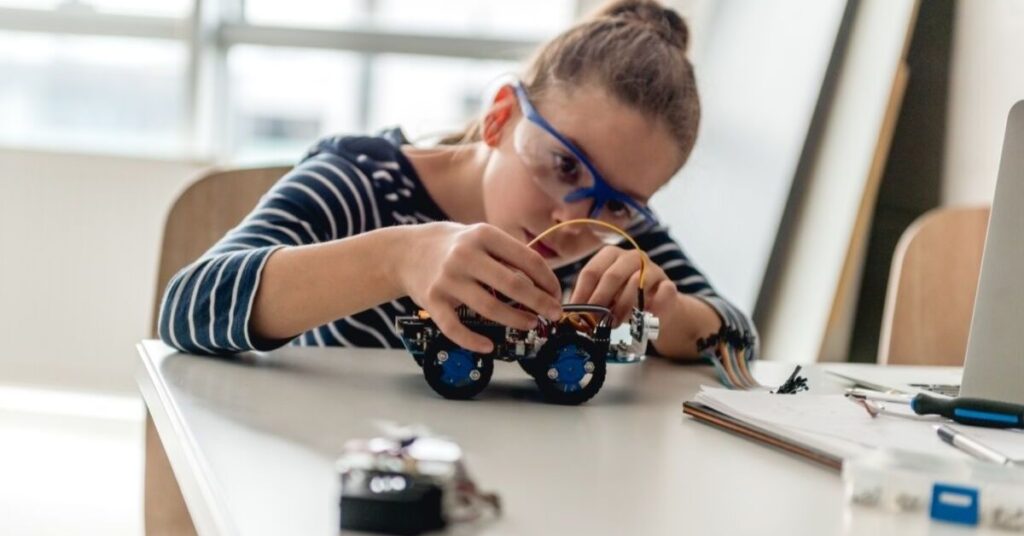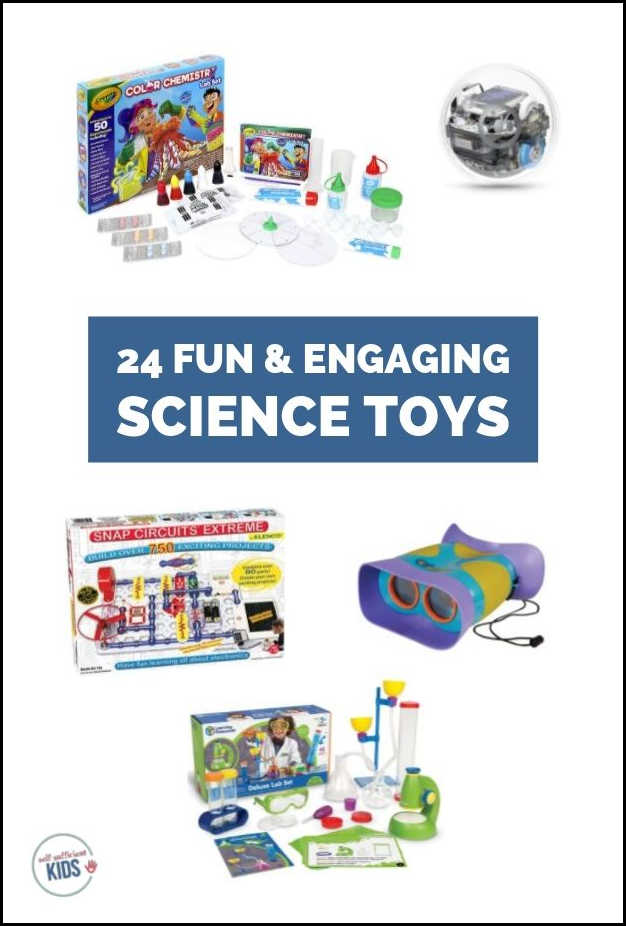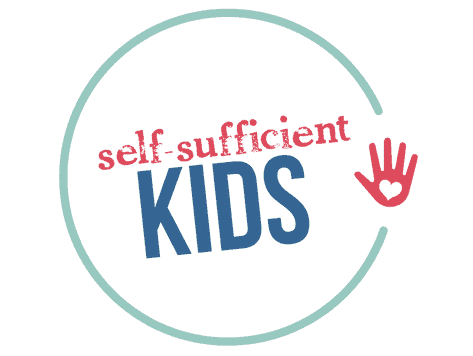24 Fun & Engaging Science Toys for Kids
These twenty-four science toys for kids introduce a range of STEM topics in fun and engaging ways. Kids won’t realize they’re learning science.

(This post contains affiliate links. If you click on a link and make a purchase, I’ll receive a commission at no extra cost to you.)
Being interested in science, it turns out, doesn’t mean kids enjoy science classes.
A 2016 study found that while 81% of students said they are interested in science-related subjects, only 37% liked their science class.
This isn’t too surprising given that most science classes in the United States are taught through books and worksheets, a number of schools only offer science once a week as a special, and funding for science classes is often secondary to “core” subjects such as math and English (giving science teachers few resources to make their classes more engaging).
And yet, having a good understanding of science is crucial to understand the world around us – to make informed decisions about ourselves, our environment, and related legislation. Plus, jobs in STEM-related fields (science, technology, engineering, and math) are expected to be among the fastest-growing over the coming years.
No child will pursue a subject very far if they perceive it to be boring.
That’s where science toys for kids can help.
Science toys for kids that make science fun
The toys below make science fun – whether it’s building a structure, playing with a robot, discovering what happens when two chemicals mix, or feeling the satisfaction of conducting electricity.
And the enjoyment of making a new discovery or tinkering with a project means kids will hardly realize they’re learning.
Think of this list as a best-of guide to science toys for kids. While our family hasn’t used every product on the list, I researched which science toys appear to be the most interesting and get the best reviews. I also tried to include a variety of toys within each section to appeal to as many interests and ages as possible.

Science toys for young scientists
These science toys are perfect for preschoolers, ages 3-5, to let them see how fun and interesting science can be.
Learning Resources Primary Science Kit: (ages 3 & up) Everything kids need for early science exploration including flasks, test tubes, eyedropper, funnel, and more. Activity cards help guide learning.
Educational Insights Geosafari Microscope: (Ages 4 & up) This talking microscope lets kids view prepared slides of animals, plants, and household items. The “fact mode” lets kids listen to commentary on what they are viewing.
ETI Engineering Building Blocks Set: (Ages 3-6) These engineering blocks provide kids with everything they need to begin creatively building a wide variety of structures.
Educational Insights GeoSafari Binoculars: (Ages 3 and up) These kid-sized binoculars help children explore nature at 2X magnification.
Engineering Toys for Kids
These engineering toys encourage kids to build and explore engineering concepts and designs.
GoldieBlox and The Spinning Machine: (Ages 4 and up) Half engineering toy, half game, GoldieBlox features a girl engineer who builds a spinning machine to help her dog, Nacho, chase his tail.
Learning Resources Pendulonium: (Ages 5 and up) This pendulum introduces kids to concepts of force and momentum. Challenges ask kids to devise their own solutions through trial and error.
Mindware Q-BA-Maze 2.0 Rails: (Ages 6 and up) Building structures is even more fun when the result is a ball maze. This 104 piece set provides kids with many creative opportunities to customize their maze. (Note that both smaller and larger piece sets are also available.)
Engino Discovering STEM: Levers, Linkages, and Structures: (Ages 8 and up) With a focus on levers and linkages, this set provides instructions for sixteen working models such as a seesaw, a movable weight scale, a wheelbarrow, a parking gate, a toy with moving figures, a pantograph and two types of linkages and 8 structure models or add some imagination and make something new.
Chemistry Kits for Kids
These chemistry kits for kids is hands-on learning at its best. Each kit comes with supplies for multiple experiments.
Crayola Color Chemistry Set: (Ages 7-10) Learn about the basics of chemistry through the science of color. This kit contains 50 science activities and enough supplies to do 16 experiments right out of the box.
Playz Kaboom! Explosive Combustion Science Lab Kit: (Ages 8 and up) One of the more fun aspects of chemistry is creating combustion. This kit contains 25 experiments and the necessary supplies. Experiments include making rockets from a chemical reaction or balloon, fizzy bombs, an explosive bag, and color explosions.
Thames & Kosmos Crystal Growing Science Kit: (Ages 10-15) Growing crystals provides a hands-on chemistry experience. This kits also teaches the structure and geometry of crystals.
Happy Atoms Magnetic Molecular Modeling: (Ages 10-17) The study of atoms is at the heart of chemistry. This modeling kit lets kids discover the world of molecules in an intuitive, hands-on way by manipulating a set of 50 atom models. The included app tells users which atoms they’re connecting together.
Robot science
Kids love robots and what better way to introduce them to mechanics, coding, and automation than through building and playing with robots.
Learning Resources, Botley the Coding Robot: (ages 5-8) Botley teaches young children the core principles of coding without the need for a screen or app. Using a remote control, kids program Botley to navigate obstacles, move in patterns, and complete simple tasks.
Giggleway DIT Electric Motor Robot Kits: (ages 8 and up) This kit lets kids build three of their own robots: an electric balance car, a doodling robot, and a reptile robot.
Smarts Toy DIT Wooden Solar Car Kit: (ages 8 and up) Kids can build and paint their own solar-powered robot car with this kit.
Sphero BOLT App-Enabled Robot: (Ages 8 and up) BOLT is an app-enabled robotic ball that kids can move by using basic or more advanced code. In addition to movement, BOLT includes programmable sensors such as infrared, compass, light sensor, gyroscope, accelerometer, and motor encoders. The app works on nearly any mobile or desktop device.
Electricity and Circuits Science
These electricity and circuits kits offer a variety of ways for kids (both young and old) to explore electricity.
Snap Circuits Beginner Electronics Exploration Kit: (Ages 5 and up) This kit provides young children with a great introduction to how to build circuits and conduct electricity. The pieces in the kit have extra safety features and easy-to-follow instructions especially designed for younger kids.
Circuit Cubes Bright Lights: (Ages 8-12) Calling all Lego fans: this kit is the perfect way to motorize and illuminate Lego creations. Circuit Cubes provides its own cubes, building bricks, wheels, and gears plus instructions to build a space rover, a monster truck, and more. But all these items are also compatible with Legos and other major brands of building bricks.
Squishy Circuits Lite Kit: (Ages 8 and up) Have fun learning about electricity while playing with playdough. This kit uses conductive and insulating play dough to teach the basics of electrical circuits. Kids can light up their creations with LEDs, make noises with buzzers, and spin their creations with a motor.
Snap Circuits Extreme: (Ages 8-15) As the name implies, this is the perfect kit for any child who has a serious interest in electricity and building circuits. The kit includes over 750 experiments with eighty parts. (Snap Circuits has a wide range of offerings so be sure to check out other options if the “extreme” version is too much.)
Toys that help kids explore the natural world
The toys below let kids explore and better understand biology, geology, and weather science.
Mini Explorer Light-Up Terrarium Kit: (Ages 6-12) Terrariums are miniature gardens that simulate a natural environment. This terrarium kit for kids includes everything necessary to create a mini-garden including seeds. An LED light in the lid allows the terrarium to light up at night.
National Geographic Mega Gemstone Dig Kit: (Ages 8 and up) This kit simulates what it’s like to mine for gemstones. Kids can dig for the fifteen hidden gemstones including pyrite, amethyst, tiger’s eye, fluorite, quartz, obsidian, and aventurine.
Animal Science Kit for Kids: (Ages 8 and up) This kit includes 10 activities such as dissecting an owl pellet, identifying animal bones, assembling real animal skeletons, conducting an experiment to turn hard bone into rubbery bones, and more.
4M Weather Science Kit: (Ages 8-15 years) This kit includes a variety of activities to help kids understand how our weather works. Activities include: experimenting with static electricity to better understand lightning, building a desktop water cycle model, making clouds, watching air currents and studying the greenhouse effect and acid rain.
You may also be interested in:
9 Awesome Science Subscription Boxes for Kids
39 Eco-Friendly Gifts for Kids of All Ages
22 Meaningful Non-Toy Gifts for Kids
What to do next…
1. Subscribe to Self-Sufficient Kids’ email list.
Like what you read here and want to learn more? Every Thursday I’ll send you one parenting tip about raising self-sufficient kids and creating the peaceful relationship you yearn to have with your child. Click here to sign up.
2. Take one of my quizzes!
Find out if you’re raising a self-sufficient kid (click here) or if you’re doing too much for your kids (click here). At the end of each quiz, you’ll be asked to provide your email address to see the results.
3. Get your kids started on chores.
Learn how to get your child started on chores (& keep them motivated + avoid power struggles) by enrolling in my Get Your Kids Successfully Started on Chores course. Click here to learn more and sign up.

About Kerry Flatley
Hi! I’m Kerry, the mother of two girls and a certified parent educator. I believe it is possible for parents to have a supportive, loving, and warm relationship with their kids while raising them to be independent and ultimately self-sufficient. Over the years, I’ve read numerous books and articles that support this belief and I’ve put these ideas into practice with my own kids. Read more about me and Self-Sufficient Kids here.
